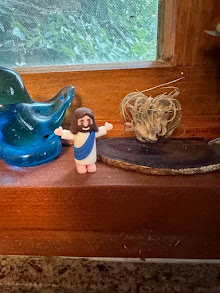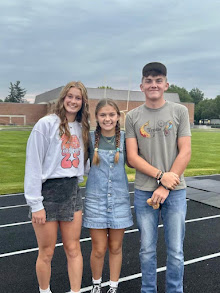
The folks with out of state plates remind me of the summer pilgrimages our family made annually years ago. Before the days of garden mum lines, we would plan eagerly for the week after the county fair, when the 4-H calves were chilled and hung in the locker, the sweet corn was bagged in the freezer, and summer sports were still in the future. This was as free as we ever got from farm, home, school and garden; I would pore over free travel literature and the Rand McNally Road atlas. Mid August in Westboro needs no description: invariably, our sights would turn West, to higher elevations, clearer air, and less humidity.
There were other reasons to go West, young Hursts. It was but a day's drive to the mountains heading west and going east meant two solid days of Corn Belt, not exactly exotic and different. But perhaps the main impetus was the sheer romance we had with the history of the lands we would traverse. The landmarks of the Oregon Trail, the Santa Fe trail, the Bozeman trail, were an outdoor, bigger than life, time machine travel museum just over the horizon. We could, and did, read about our nation's Manifest Destiny; we were farmers, tillers of the land and familiar with the challenges of making a living from our native soil. Our little town sat lightly on the land, a few years past a century old, as ephemeral as the ghost towns bypassed by railroads of the last century. The emigrants of the Oregon Trail weren't relatives by name, but they were kin by spirit as they took that leap of faith in Independence, crossed the prairie streams of northeast Kansas and followed the Platte, so foreign in nature from the narrow woodland creeks of the East. For our journey, Lincoln, Nebraska was far enough west to be foreign territory...or maybe we took off south first, stopping at the Pony Express station in the limestone fence post capital of the world, Marysville, Kansas. The Platte was flat and lazy under its bridges along I-80 as we marked the mile posts. Gibbon, with the Windmill Park. Grand Island with the Stuhr Museum. Kearney with its military fort and Harold Warp's Pioneer Village, an icon of travel past, south of town. (an aside: the Warp company still manufactures the poly plastic film we use on our greenhouses).
Somewhere before the town of Gothenburg, where the city park sported another Pony Express Station, we crossed the mythical 100th parallel. Cozad, Nebraska straddles that barrier along I-80 and proclaims its presence with sky breaking concrete elevators spelling out the letters C-O-Z-A-D. We passed Cozad for years without stopping, even though there was an art museum there. I knew nothing about Robert Henri, but he grew up in Cozad in a modest two story gray frame house with sloping floors and the smell of age. The prints in the catalog showed rain swept street scenes and European cafe life, a far cry from the Great Plains.
At whatever time we reached North Platte, we made the stop. North Platte, the home of Buffalo Bill Cody and his red barn with the built in advertisement on the roof. If seeking the West, how could one not pay homage to the grandest promoter of them all? North Platte itself is dusty and no nonsense. Buffalo Bill Cody is the romance at its heart, just like the cowboy hero of the movies.
Our road trip turned off the interstate as the land rose and the humidity fell. Here the pioneers rested before ascending the broken terrain at Ash Hollow. We could drive between Chimney Rock and Scotts Bluff in a hour or so, but the wagons west must have seen those landmarks for days. Now there is a museum with a nicely framed view of Chimney Rock and information, maps and excerpts from diaries. Twenty years ago, there was a construction type trailer( closed), a historical marker, and some colossal mosquitoes, according to the girls. The winding road to the top of Scotts Bluff is another remnant of the WPA, worth preserving because no one can build roads on monuments any more. My mother was born in Scotts Bluff while my grandfather was working in western Nebraska, the road and tunnels of Scotts Bluff one of the projects he worked on. From the summit, I tried to visualize the verdant patchwork of crop ground and arid pasture as parched and lonesome as it must have been in the early thirties, then narrowed my vision further til the scene from William Jackson Turner's paintings came to life below me.

The imprints of the wagon train wheels scored the softer rock near Guernsey, Wyoming to a depth of four feet. While the white cliffs had its share of modern graffiti, the names and dates of the 19th century could be spotted as well. These inscriptions bring a shiver wherever they appear on the trail, as well as a certain sense of reverence. I doubt the wind ever ceases near Independence Rock, in the midst of the Rattlesnake Hills, along the stretch of the Trail that includes Split Rock and the Devils Gate. A landscape of desolate beauty these days, the isolated ranches do nothing to dispel the pervasive feeling that humanity is merely passing through. It is a long way to anywhere populous on this road....while we traveled it, the kids napped and I pondered the emotions of folks who had gone too far to turn back.
Our week long vacations were too short to finish the pioneer trail to the promised land of Oregon. We would leave our wagon trains to cross most of the mountains and find the Columbia on their own. We might follow the Sweetwater on up to the South Pass, picnic amid the remnants of South Pass City, and wend our way through the jagged youthful mountain ranges of northwestern Wyoming. One year we followed the Bozeman Trail past one ill fated fort after another through the bastion of the Indian Wars. The folly and foreboding ended at the Little Big Horn where the summer winds rustled golden grasses between the headstones and we read descriptions of the battle to each other in hushed voices. We've been lost on the ranch roads of the Powder River, had the highway to ourselves in the Hole in the Wall country, and frozen our toes in the bubbling Wind River.
Aaron and I used our time wisely this March in Washington, D.C. We entered the halls of the Smithsonian museums like it was a library full of volumes to browse, or a buffet of exotic dishes, too many to sample at one sitting. And, with an inquisitive seven year old, whetting the appetite was probably just the ticket for future memories and inquiries of a more lengthy and serious nature. But a week long trip to our beautiful West was a different type of experience, one that concentrated the mind on the majesty of the breadth and depth of our nation. The ambitions of our pioneer immigrant and emigrant ancestors used to be celebrated in novels and textbooks alike. I don't know if that is the case these days, but our kids learned their stories in the giant open air museum of our Western road trips. Mountain men, Indian chiefs, dusty U.S cavalry, lumberjacks, railroad magnates, gun fighters and ranch hands: all these came to life just over the next curve of the road. They still do. Grab your Road Atlas and go.















No comments:
Post a Comment